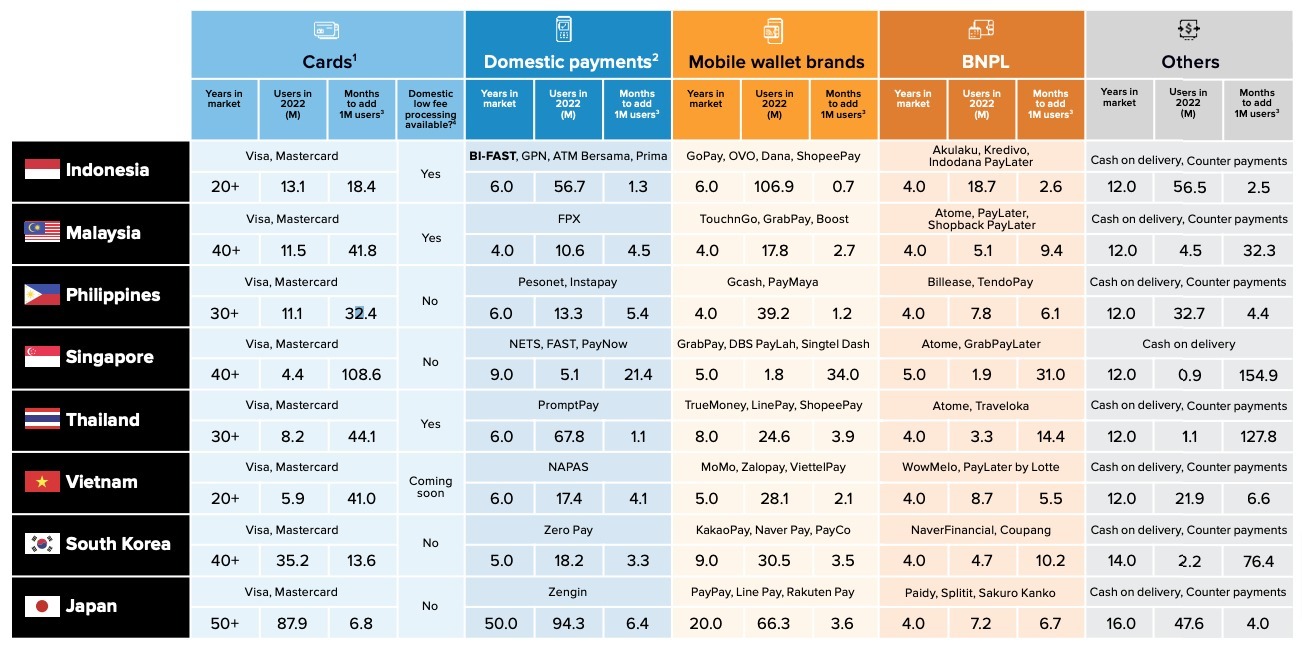Here's a not-so-fun fact: Out of 100 customers in Asia Pacific (APAC) who add items to their cart, only 20 are likely to complete a purchase.
That's because the APAC region has the highest cart abandonment rate in the world — 10% higher than in the Americas (72%) and in Europe, Middle East and Africa (73%).
Despite the challenge of getting APAC shoppers to complete their purchase, more merchants in the US, UK, and Canada are wooing customers in the region. APAC, after all, is home to more than half of all internet users around the world.
It's also home to diverse markets with their own consumer trends and preferences. Understanding these nuances can help you reduce your cart abandonment rate and capture a bigger slice of these markets.
What is cart abandonment?
Cart abandonment occurs when a shopper adds one or more items to an online shopping cart but decides not to complete the purchase. This behavior is a natural outcome of the online consumer shopping experience — it's easier to abandon a full cart when it's only an icon on a screen, rather than in a physical store.
How to calculate the cart abandonment rate
A simple way to compute your cart abandonment rate is to divide the total number of successful purchases by the total number of shopping carts created over the same period of time. Afterwards, subtract that figure from 1 and multiply it by 100.
Let's say you had 90 successful purchases out of 300 carts created. The computation would be as follows:
- 90 ÷ 300 = 0.3
- 1 − 0.3 = 0.7
- 0.7 × 100 = 70
This means your cart abandonment rate is 70%. As the data above shows, this is on par with the average for the US, but is significantly lower than the APAC abandonment rate.
Common causes of cart abandonment in Asia Pacific
When people abandon their carts, chances are the culprit lies somewhere in your checkout process. Check your web analytics data to identify where the abandonment typically occurs within the checkout flow.
For instance, do most consumers abandon their cart when they see the shipping fee, when they get to the payment step, or when you require them to create an account instead of letting them check out as a guest? Try tweaking one part of the checkout process at a time and observe how abandonment rates change.
Here are some factors that typically cause cart abandonment among shoppers in Asia Pacific:
- Shipping costs and unexpected fees: Higher-than-expected delivery charges and other fees at checkout are the top reason for cart abandonment for shoppers worldwide. Unexpected and steep fees right before checkout led 55% of shoppers to abandon carts in 2023.
- Slow delivery times: Shoppers from APAC countries are the most frequent cross-border shoppers, with 20% of Chinese and 23% of Thai shoppers buying goods from another country at least once a day. However, seeing long delivery periods can deter them from completing a purchase.
- Poor design: With 78% of APAC consumers using smartphones to shop, mobile-responsive websites and apps are vital. Slow, laggy platforms that aren't mobile-friendly lead to abandoned carts.
- Data privacy concerns: APAC customers have strong concerns regarding data security. This unease not only affects initial willingness to shop, but can also contribute to higher cart abandonment rates as shoppers weigh the risks associated with sharing personal information against completing their transactions.
- Lack of local payment options: Shoppers in APAC have diverse payment preferences beyond traditional credit cards. When they don't see their preferred payment method, 44% of shoppers will abandon their cart.
How to lower cart abandonment rates among shoppers in Asia Pacific
The causes of cart abandonment rate in APAC show that you need a multi-faceted approach to nudge shoppers to finish the checkout process. Here are five things you can do to remove barriers to purchase completion:
1. Be transparent about costs
Cost transparency beyond mere product pricing is key to building trust and encouraging positive review. Being upfront about shipping, customs and other charges, or even rolling these costs into a product's price, can reduce cart abandonment by over 50%.
2. Improve delivery lead times
Even as a merchant, you can influence the customer's delivery experience.
You can do this in several ways:
- Manage expectations through parcel tracking
- Evaluate suppliers routinely to catch supply chain disruptions and plan ahead
- Bulk-order products with a high sales volume to reduce supplier interactions and minimise potential delays
- Adopt a logistics fulfilment model that's suitable to your target market (for instance, B2B2C fulfilment for archipelagos like Indonesia and the Philippines)
- Switch to a delivery service provider with a wider reach across the region.
By adopting these strategies, you can boost customer assurance and confidence in your online shopping experience.
3. Create a mobile-friendly experience
APAC encompasses a wide range of countries with varying internet speeds. Countries and regions in the East and North-East like Hong Kong SAR, the China mainland and South Korea have the highest download speed economies ranging from 93Mbps to 125Mbps. In contrast, countries in the Pacific subregion like Mongolia, Kyrgyzstan and Kazakhstan have the lowest download speeds ranging from 16Mbps to 22Mbps.
This means your customers in different parts of the region can have vastly different experiences on your website. A site that works smoothly in one country can be laggy and unresponsive elsewhere. Creating a mobile-friendly experience is especially crucial, as more than half of e-commerce purchases in APAC (excluding Japan) take place on mobile devices.
While you can't control the many different internet speeds in the region, you can improve the customer's buyer journey by providing a mobile-friendly design and fast page loading speeds. A good benchmark is Google's Core Web Vitals criteria, which measures different facets of a website's user experience.
4. Establish trust
One of the most basic ways to garner trust from customers is with the Secure Sockets Layer (SSL) certificate and HTTPS (secured version of HTTP protocol) and lock symbol in the search bar. This combination signals that the page uses an encryption protocol and safely delivers encrypted data that cannot be read by a third party.
Another way to establish trust is by using online word-of-mouth marketing through online reviews. Customer reviews influence most (98%) of global shoppers in varying degrees. Consider incentivising your customers who've made verified purchases to review your products, such as by rewarding them with loyalty points or a voucher for providing honest feedback on your site.
5. Offer local payment methods
The inclusion of localised payments is proving to be perhaps the single-largest determinant between success and failure for Western businesses looking to expand in the East. Merchants that do not provide APAC shoppers with localised payments stand to lose 32% more of their sales to cart abandonment compared to those who do.

Above: E-commerce payment preferences across Southeast Asia, Korea and Japan (Source: IDC Infobrief sponsored by 2C2P and Ant Group, How Asia Buys and Pays 2023: Tapping into Asia's Regional Commerce Opportunities, IDC #AP241443IB, Published October 2023)
To increase the likelihood of APAC shoppers completing their purchase, offer the payment methods that shoppers in your target market prefer. The chart above, for instance, shows the diversity of payment methods preferred by online shoppers in Southeast Asia, South Korea and Japan. These include digital wallets, Buy Now Pay Later (BNPL) offers, bank transfers, and other local payment methods.
Expand your business to Asia Pacific with Antom
Reducing cart abandonment rates is essential for merchants who want to increase their sales in APAC. However, the diversity of the region can make it difficult to address each market's needs.
Take, for example, the complexity of offering local payment methods all over the region. You'd have to understand the various payment methods used in each market, have a deep grasp of the regulations in each country, and partner with multiple different providers.
This is where Antom can help. A single integration with Antom gives you access to an ecosystem of over 250 payment methods across more than 40 countries and regions — including the most popular payment methods in APAC, like Alipay, GCash, Paynow and Touch 'n Go. Our e-commerce solution is packed with features to help e-commerce merchants boost their revenue, reduce treasury management costs, and expand into new markets quickly. With our deep market knowledge, powerful payment technologies and extensive partnerships network, we're ready to help your business scale in APAC.
If you're ready to grow your revenue in the Asia Pacific region, reach out to our payment experts today.





